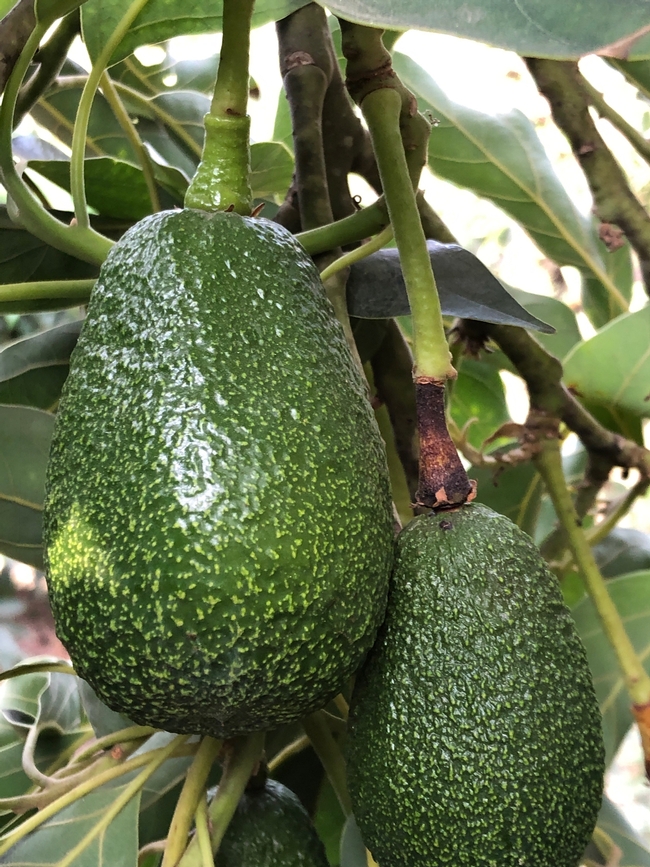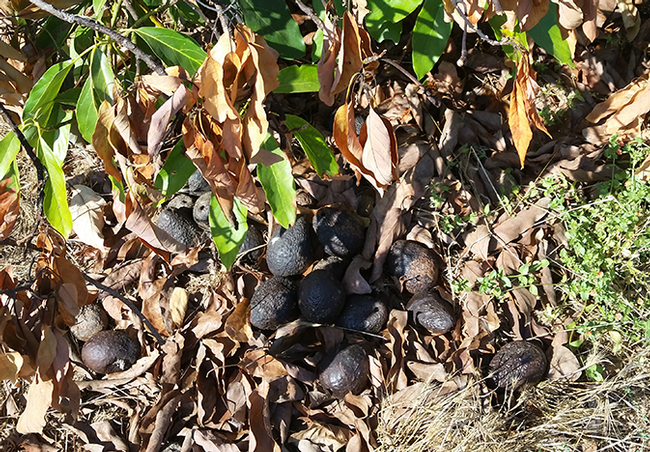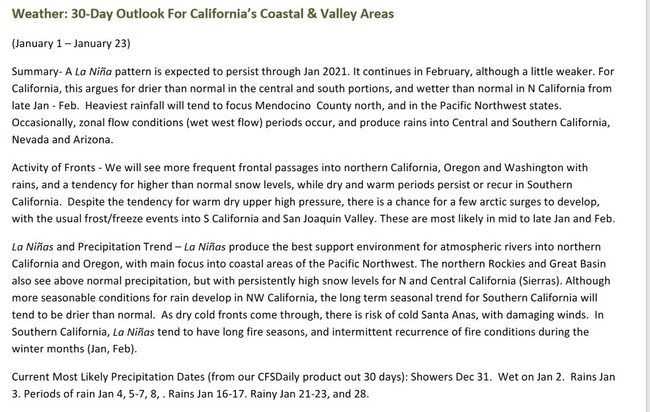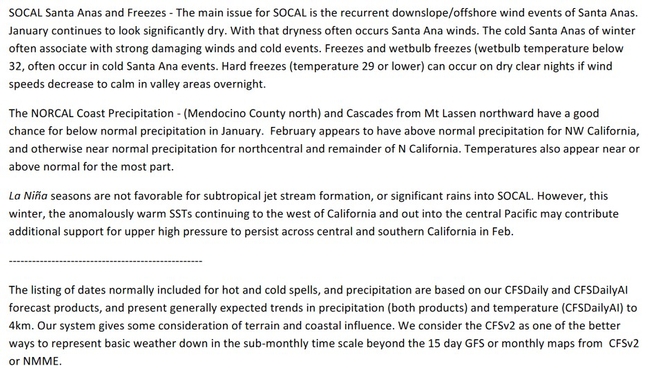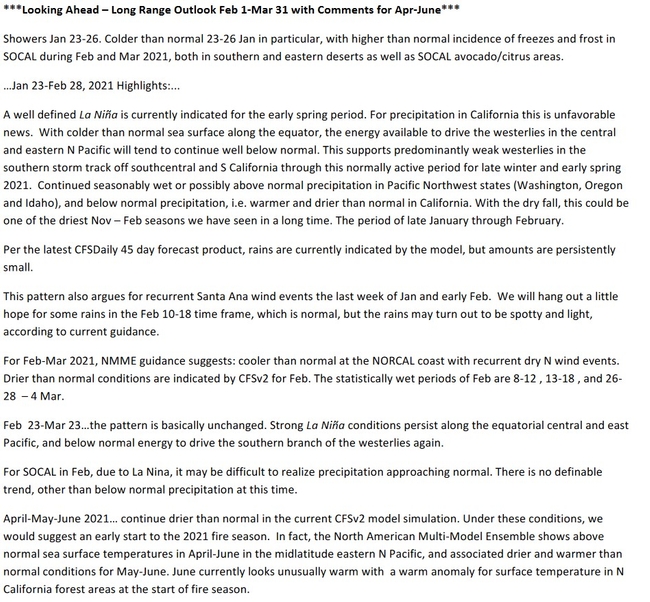
Posts Tagged: damage
Avocados Get Hot
If you see significant leaf drop in your groves due to excessive heat, the following actions are recommended:
- As soon as possible, whitewash branches exposed to the sun with special attention paid to branches on the west and south sides of the tree.
- Trees that lose a significant portion of leaves cannot efficiently move water, therefore restrict irrigation amounts to ensure you avoid creating wet, soggy conditions that can lead to root rot. It's best to irrigate less frequently and with smaller amounts of water.
- Do not prune your trees — leave hanging leaves in place to protect the tree from sunburn. Once new tree growth has occurred (in the next 3 – 6 months), pruning can take place on living wood.
- Adjust fertilization as you would with a frost-damaged tree: reducing the amount of fertilizer until the tree is re-established. If you see signs of a particular nutrient deficiency, adjust fertilization accordingly.
For more information about managing heat in avocado groves, growers can view the following articles on the California avocado growers' website:

heat damage gem avop
Invasive Goldspotted Borer Hits California Oaks
By Julie Clark, Community Education Specialist III
Goldspotted borer (GSOB) is a beetle invasive to oaks in California. Infestations have ravaged oak woodlands in San Diego and Riverside counties the last 12 years and in Anaheim Hills, Angeles and San Bernardino National Forests the last few years. Preferred hosts are black oak, canyon oak, coast live oak, and occasionally Engelmann oak.
Oak woodlands are highly valued ecosystems that support numerous species of fauna. Oak trees serve as the anchor for these systems and support over 5000 insect species, over 105 bird species, 105 mammal species, 58 species of amphibians and reptiles during their respective life cycles. Many beneficial insects rely on oaks to complete their life cycles and do not damage the trees in doing so.
GSOB bore into the bark of its hosts to lay eggs and rear young. Mature beetles emerge to find new hosts. The adults leave a distinctive D-shape hole in the bark upon exit. 
The insects damage the water and food transfer structures (xylem and phloem) of the tree, causing crown die-back and eventual death in heavily infested (amplifier) trees. Widespread loss of oaks from GSOB has occurred in Idyllwild and San Diego County mountain areas.
Although GSOB are winged, they do not fly long distance. UC researchers, partners with CAL FIRE and the California Firewood Task Force discovered that several of the infestations throughout Southern California were caused by introduction of firewood imported from infestations in other areas. 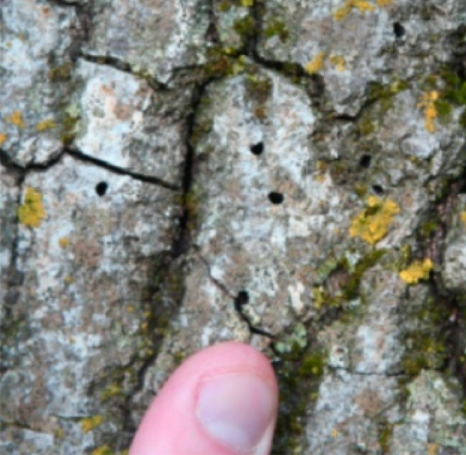
D-shaped GSOB exit holes. Credit: UC ANR
Ventura County is vulnerable to attack by the beetle and other invasive tree pests that are on watchlists for the area. Best ways of being assured your firewood is safe include purchasing locally source material or selecting kiln-dried or certified firewood.
For more information:
Report suspected GSOB infestation:
https://ucanr.edu/sites/gsobinfo/What_You_Can_Do/Report_GSOB_Symptoms/
Heat Mitigation Around the World - Avocado
Heat Mitigation Around the World
A chance to hear what can and is being done by growers
to reduce the damage inflicted on avocado fruit and trees
World wide Speakers:
Click here for the June Seminar/Webinar Recording

heat damage to avocado leaves

Heat damaged young avocado fruit

heat damaged young avocdo tree
Frost and Frost Protection
You wanted to know all about Frost, well it's all here. Emeritus Rick Snyder put it together over the years and it's at your finger tips.
English Frost Protection Training Units (videos)
Spanish Frost Protection Training Units (videos)
When to Turn Sprinklers On and Off for Frost Protection
FP001 Quick Answer—This quick answer provides information on using a psychrometer or temperature and dew point data to determine when to start and start sprinklers for frost protection.
Predicting Temperature Trends during Freeze Nights
FP002 Quick Answer—This quick answer gives a method for predicting the change in
temperature during a calm, radiation freeze night.
A Simple Method to Measure the Dew Point Temperature
FP003 Quick Answer—This quick answer provides information on how to measure the dew point for use in estimating minimum temperature and for starting and stopping
sprinklers for frost protection.
Sprinkler Application Rates for Freeze Protection
FP004 Quick Answer—This quick answer provides information on the sprinkler
application (precipitation) rates needed to protect crops from freezing.
Principles of Frost Protection
Frost Protection Training Units (videos) on measuring temperature, frost protection with water, frost protection with wind machines, and passive protection. Traning units are availble in English and Spanish .
FP005 Quick Answer—This quick answer provides information on the general principles of well-known frost protection methods. A PDF file of the WEB page can be uploaded from this Quick Answer. In addition, a shorter version is available.
Programs for Estimating Frost Night Minimum Temperatures and Temperature Trends (new 7 Mar 2007)
The FFST Excel application programs FFST_E.xls and FFST_M.xls are available from this link. The FFST application helps users to determine an empirical equation for estimating minimum temperatures during radiation frost nights. Note that the program will provide good estimates if there is little or no wind, no significant cold air drainage, and no clouds.
The FTrend Excel application programs FTrend_E.xls and FTrend_M.xls are available from this link. The FTrend application program is used for estimating changes in air and wet-bulb temperatures during a frost night. The application is useful for predicting when to start sprinklers for frost protection and for other methods as well.
Estimating Risk of Frost Damage from Climate Data (new 8 Jul 2006)
One of the programs included with the book Frost protection: fundamentals, practice, and economics. Volume 2, which is available from the UN FAO is the Frisk program. Information on how to obtain the book is presented above on this web page. Based on reader feedback, some improvements have been made to the Frisk application since the book was published. Updated versions of the application are made available to the public here. The Frisk program is an MS Excel application that is designed to help growers to make decisions on the risk of frost damage in a particular location. The user inputs the local climate data and a critical damage temperature, and the application computes the probability of temperature falling below the critical temperature on each day of the year. These data are then used to estimate the length of the growing season relative to the critical temperature by presenting a graph of the probability that the growing season will be less than a specific number of days. The application also computes the certainty that no air temperature will fall below the critical damage temperature after a selected date in the spring or before a selected date in the fall for design periods of 5, 10, …, 30 years. This certainty of no events is equivalent to the risk of having one or more events during the same time period. Although Celsius temperature was used in the example application programs, the program works equally well using Fahrenheit temperature. To obtain a copy of the application, click on FriskNH.xls for the northern hemisphere or FriskSH.xls for the southern hemisphere. Note that metric units were used in the Frisk application sample data.
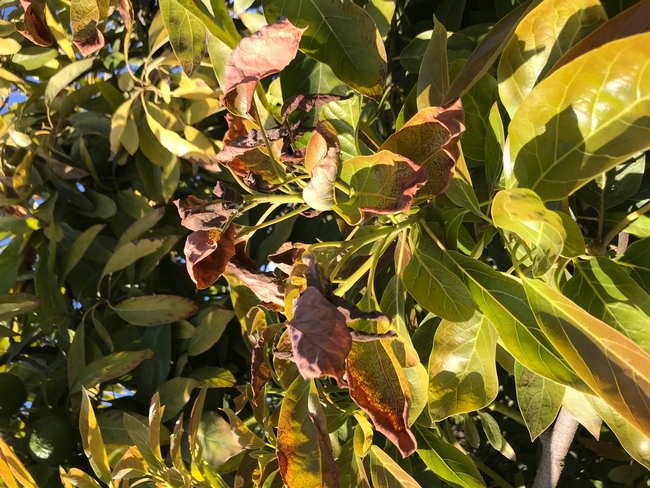
frost damage leaves
It Could Still be a Cold Winter
A moderate La Niña climate phase is expected through spring 2021. This indicates that slightly above average temperatures and slightly less rainfall than normal can be expected in California's avocado/lemon growing areas.
The fact that the winter weather pattern is expected to be warmer than usual doesn't rule out the possibility of a freeze. A freeze can occur any winter, regardless of the climate phase. And dry winters are often susceptible to sudden cold spells because of the lack of tempering effect of soil wet from winter rains
La Niña is one of three climate phases that are part of the El Niño Southern Oscillation (ENSO) climate pattern. Others are El Niño, during which colder and wetter conditions are expected in California, and neutral, when conditions are neither El Niño nor La Niña.
California's most severe freezes have occurred in weak La Niña, weak El Niño or neutral ENSO phases. Severe freezes in Decembers of 1990, 1998, 2001 and 2006 occurred after droughty years and years of low rainfall. In 2015, it snowed in Temecula and again in 2020 – in February!!! So cold weather is still waiting out there.
The most damaging freezes for avocado and citrus are advection and radiation freezes. In advection freezes, cold fronts move arctic air through the region. Radiation freezes feature overnight clear skies and light to no winds with periods of calm. Cold pockets and cold locations will have lower temperatures during radiation freezes. Break freezes and unsettled freezes are the other types of freezes.
During a radiation freeze, cold air drains down and pools in low areas. Know the cold pockets in your grove, and keep that air flowing with a wind machine, if possible.
Read the collected works on frost protection, frost damage and frost recovery here:
https://www.californiaavocadogrowers.com/growing/cultural-management-library/freeze-protection
It's also a good idea to be ready for fires in years of low/no rainfall.
The 2021 Weather Forecast from Fox Weather provided by CAC is below:
Image: Temecula snow on avocados in February
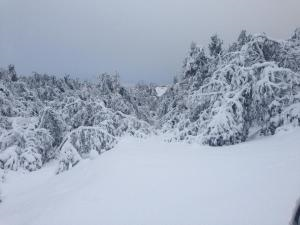
avocado snow Temecula

